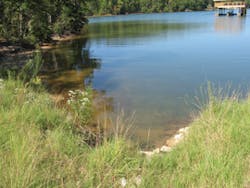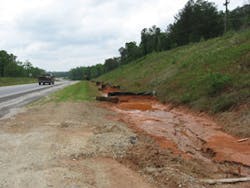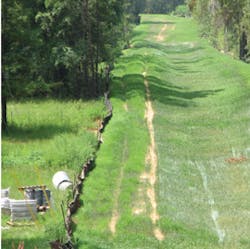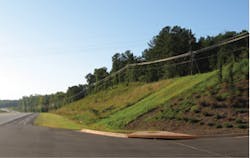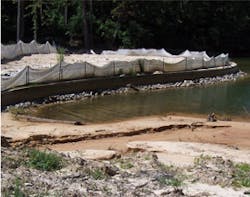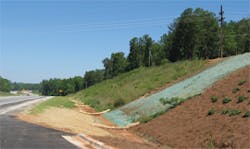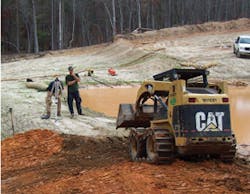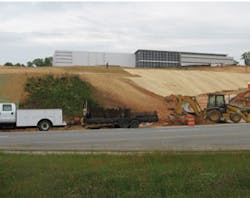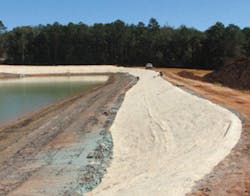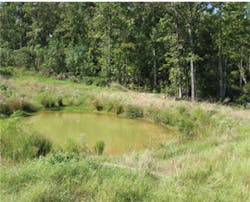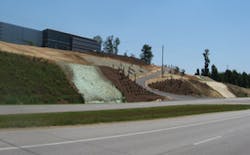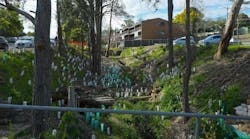It’s usually a smart decision to work with nature when you need to overcome the challenges she presents. When you’re working to revegetate an area, you just can’t always assume nature is willing to work with you.
Erosion control blankets and turf reinforcement mats can be the solution in these instances, balancing a natural look with the strong sediment control you need. Turf reinforcement mats can provide stable, long-term anchors for plants that are necessary where there are steep slopes or increased shear stresses from water flow. While they often contain geosynthetic materials, they work with natural vegetation and can blend permanently into a living environment. Erosion control blankets can provide short-term or long-term erosion protection in a variety of areas, including high-flow areas such as swales and channels. They can also be made from biodegradable materials, which break down as vegetative roots mature.
Environmental professionals in a variety of states shared the ways they’ve used erosion control blankets and turf reinforcement mats to meet the revegetation and sediment control challenges that arose on sites that had different goals and erosion control solutions, but shared the same threat: the steady onset of water flow threatening the stability of their project.
Standing Up to High Velocities
During the summer of 2008, drainage became a problem within a commercial development in Beatrice, NE: the water flow needed to be channeled in a more effective way. Rex Behrends, city engineer for the city of Beatrice, says this phase of an ongoing project had to be completed between rains during a wet time for the area.
Concrete was first added to line the bottom of about half of the approximately 700-square-foot drainage area. Working with an erosion control budget of about $30,000 to $40,000, the city applied Presto Products Company’s Geoweb cellular confinement system to the sides of the ditch. Topsoil was added to the cells before the area was seeded with fescue.
“Then workers put C350 reinforcement mat over that,” says Behrends.
Before stabilization measures were implemented at APR Tuned in Opelika, AL
There are perforations in the Geoweb cell wall, and the pattern of holes promotes root lock-up, stabilizing the vegetated system and allowing lateral drainage. Presto Products also creates integral polymeric tendons used to anchor the cellular systems to sloped sites or embankments. The tendons also work when a site has a geomembrane underlayer or very hard rock or soil below.
“We had a fairly large volume of water coming down this ditch; we needed something to handle the velocity. We thought we’d give it a try,” says Behrends. “Construction-wise, it went a lot quicker than the contractor thought. It went down fairly quickly. This should be a permanent solution.”
Excess water flow at another midwestern site came to a head in August 2007. Developers at the Hadley Creek Golf Course and residential subdivision project in Rochester, MN, found themselves facing flooding concerns.
“We had some erosion concerns because we have an intermittent stream that can be dry part of the year,” explains Bill Anderson, project engineer with Yaggy Colby Associates in Rochester. “We have a wide flood plain.”
Trying to make the landscape work with the golf course was challenging, but Anderson says North American
Mats and grass seed helped establish long-term groundcover on this site.
Green’s Vmax3 composite turf reinforcement mats worked well. These mats feature permanent, three-dimensional matting with fiber matrix material that provides both erosion control and support for vegetation by regulating the moisture and temperature that reaches the seedlings.
“By using the Vmax, we could keep it looking good and-we hope-handle the water during the peak storms,” says Anderson. “Where we have steady flow, consistent low flow, we used cabled concrete drop structures. Where we were able to let the structures dry out, we used the Vmax.”
Working with a budget of about $100,000 for erosion control and seeding during this phase of the ongoing project, the company used different seed mixes at the site depending on whether the area was a wetland, fairway, or slope. More than 100 acres of the site were seeded as part of the long-term revegetation effort.
Nurturing Long-Term Vegetation
Battling the weather can pose the biggest challenge for site workers, and Florida weather is notoriously tumultuous. When large amounts of earth were moved at a very large Wal-Mart site in Tallahassee, FL, extremely steep slopes were created that had to be stabilized in time to meet the challenge of the summer 2007 weather.
The APR site was challenging because of
the severe topography and piedmont soils.
“The summer weather in Florida is very wet, with very frequent afternoon thunderstorms-four to six per week-as well as the constant threat of hurricanes and tropical storms,” says John Allen Corry, owner of Tallahassee-based erosion contractor CSC Inc. “Also, the site is situated alongside Lake Lafayette, an extremely environmentally sensitive area. The overflow drainage ditch where the Recyclex was used actually drains directly into the lake. So it goes without saying, we definitely needed soil stabilization quickly, and of good quality to last.”
CSC achieved its goal of establishing long-term groundcover by planting a mixture of both temporary and permanent grass seed, and applying American Excelsior Company’s Curlex erosion control blankets and Recyclex turf reinforcement mats to the site’s slopes.
“The hydroseeding mix contained 1,500 pounds per acre 70/30 blend mulch with tack, 450 pounds per acre 19-19-19 fertilizer, 2.5 gallons per acre liquid lime concentrate, 30 pounds per acre common hulled Bermuda grass seed, 50 pounds per acre Pensacola Bahia grass seed, and 15 pounds per acre of browntop millet seed,” says Corry.
“Approximately one month after we applied hydroseed, Curlex, and Recyclex, the browntop millet was mowed
A sediment remediation plan was made to remove sediment from Lake Martin.
to about 6 inches to kill it and stop it from competing and shading out the young permanent grass.
“By allowing the fast-growing millet to get up and start to establish before mowing,” he explains, “you benefit from its root structure by helping to hold the soil in place, while the slower-to-develop permanent grasses mature.”
The company was working with a budget of approximately $150,000 for hydroseeding, Curlex, and Recyclex, and an estimated
budget of $100,000 for all other erosion control methods applied to the site, including silt fencing. The Curlex blankets are composed of curled, interlocking Aspen excelsior fibers, which swell slightly when wet and form a strong fiber matrix. The product is designed to train water flow to follow this matrix as the blanket’s rough surface slows velocity, permitting water to enter the topsoil slowly in an effort to encourage the best growing conditions for the new seed.
The Recyclex turf reinforcement mats are created from 100% recycled fibers from plastic bottles that have been crimped to form an interlocking curled fiber matrix, which, like that of the Curlex blankets, slows water flow velocity. Two layers of UV-resistant polypropylene netting hold the fibers in place, forming a three-dimensional matrix designed for long-term revegetation solutions.
Eighty-five percent of the runoff from the APR site drains to the right of way.
CSC selected the blankets and turf reinforcement mats to support the permanent grass because of their “high quality, excellent customer service, and great results,” says Corry.
When erosion threatens homes, it can begin in subtle ways.
Sometimes, the water itself will creep to the homeowner. During the summer of 2002, Mark Egner, lawn care manager for Best Lawns based in Streamwood, IL, worked to protect a Wheeling, IL, backyard that bordered a lake from further erosion.
The site has a 60- to 80-degree slope, and Egner says Floodwood, MN-based Mat Inc.’s Grass-Mat erosion control mat with fibrous mesh was used to help revegetate the slope after a variety of solutions had been tested.
“Once the grass gets established, the mat disappears. We did like that characteristic of that particular mat.
A combination of erosion and sediment control techniques was implemented for long-term stabilization at the APR site.
There was no following up. We didn’t have to remove it,” he says. “We planned everything in the summer time. There is no irrigation. We just waited for mother nature to irrigate.”
Grass-Mat, created from a blend of corn stover and aspen or birch wood fiber, is reinforced with polypropylene netting that’s photodegradable. Designed to help with revegetating either flat or sloped areas, the product is manufactured in 5-foot widths but can be custom made to any desired length. Grass-Mat is designed to allow light to reach the new vegetation, but protect it from harsh wind that could disturb the soil.
“We certainly do the research on the pricing. The project was done for a homeowners’ association,” says Egner. “It’s still there. It’s worked very well.”
Sedimentation Concerns
Further south, another lake project was threatened by erosion.
The finished floor elevation is approximately 55 feet above US 280, with slope grades in excess of 50%.
During the Water’s Edge project on scenic Lake Martin in Tallapoosa County, AL, a temporary basin’s design to protect a site from overwatering had some unexpected benefits.
Erosion Pros LLC was hired to design a sediment remediation plan, with the goal being to remove sediment from the lake, considered to be one of the state’s most critical waters by the Alabama Department of Environmental Management (ADEM), and to create a construction best management practices plan that would bring the site into compliance, explains Joel Seawell, CPESC, founding member and owner of Erosion Pros LLC based in Auburn, AL.
“Highly erodible soils, turbidity concerns, regulatory orders, and the fact that the site discharges directly into Lake Martin were the main challenges on this project site,” he says, adding that both plans had to be approved by the US Army Corps of Engineers and the ADEM. “We had to perform the operation right in the middle of the rainy season, which also presented several challenges during basin construction.”
There were sand deposits throughout the site, and the soil was determined to be loamy and have light clays.
A temporary basin designed to protect a site from overwatering
Begun in June 2005, the Water’s Edge project is currently on hold as a new owner/developer, The Musslewhite Group, plans to build a multifamily luxury condominium complex at the site.
“The new owner purchased this parcel from the previous developer in fall of 2006. The previous developer had left epic erosion and sediment control issues behind, and had discharged large volumes of sediment into Lake Martin,” says Seawell.
A combination of erosion control techniques was used at the approximately 9-acre site, which drains into two natural drainage channels on either side of the property that discharge into the lake.
“Our design consisted of constructing a wet detention/temporary sediment basin in the larger eastern drainage channel and diverting all of the project runoff into the basin. This essentially cut off all drainage to the eastern channel, which we converted into a vegetated slope once the sediment removal operation was approved and implemented,” explains Seawell.
The slopes were covered with double-net wheat-straw erosion control blankets.
The company used American Excelsior’s Recyclex TRM for the emergency overflow channel. “The product was used as a spillway channel liner for a wet detention pond/temporary sediment basin designed by Erosion Pros,” says Seawell. “Being that this sediment-trapping facility was designed to be temporary, we determined that the Recyclex would be more cost effective than riprap, would meet the permissible shear stress requirements of the design storm flows, and would be easier to dispose of once the temporary sediment basin is removed.”
Additional erosion control methods added to the design’s success.
“Diversion berms, check dams, soil-specific polyacrylamide, temporary and permanent hydroseeding and mulching, wheat straw mulching, the wet detention/temporary sediment basin, Alabama department of transportation type A silt fence sediment barriers, and the Recyclex-lined 15-foot overflow is the extent of the BMP treatment train used at this site,” says Seawell. “Several hundred cubic yards of sediment were removed from Lake Martin while the water elevation had been lowered for the rainy season, and impacted areas were reclaimed.
“The cost for erosion control for this project ended up around $35,000 for permanent stabilization, including
Blankets composed of curled, interlocking fibers that swell slightly when wet
BMP design, excluding basin earthwork, and excluding sediment removal from Lake Martin.”
Full perennial coverage around the basin, in concentrated flow areas and the Lake Martin area, were the project’s revegetation goals, according to Seawell.
“Temporary vegetative cover was accomplished for the remaining acreage and will be maintained until construction resumes,” he says. “Full perennial coverage of permanent vegetation, trees, shrubs, and groundcover plantings-on areas not covered by impervious surfaces-will be the revegetation goal as the project moves forward. ADEM requires all areas to be fully stabilized for National Pollutant Discharge Elimination System [NPDES] permitted sites to be terminated in Alabama.”
The Water’s Edge project after it was brought into compliance
Site topography, soils, and drainage leading into an Alabama department of transportation right of way provided the dominant challenges at APR Tuned, an Opelika, AL-based facility that provides performance engineering for a variety of automobile manufacturers including Audi, Porsche, and Volkswagen. Contractors began work on the site in March 2007.
“The APR site was extremely challenging because of the severe topography and the piedmont soils present at the site. The finished floor elevation of the facility is approximately 55 feet above US 280, with slope grades in excess of 50%,” says Seawell, whose company worked with Auburn, AL-based general contractor Donald H. Allen Development Inc. at the site. “The piedmont soils associated with the project site presented turbidity concerns. Eighty-five percent of the runoff from the site drains to the right of way. It discharges to an unnamed tributary of Saugahatchee Creek, which is infamous in the area for having erosion- and sedimentation-related environmental impacts.”
There wasn’t much room for workers to create the stabilization measures that were implemented.
A combination of erosion and sediment control techniques were employed at the site. Erosion Pros designed and implemented cost-effective systems that can be used for long-term stabilization and that will protect water quality.
“On the west side of the main entrance and along the main entrance, slope grades at 50% (2:1) were benched, and the runoff was diverted back to the west at a 2% grade. That runoff is allowed to spread out and drain in sheet flow over a 60-foot-wide Recyclex-lined slope,” explains Seawell.
Workers hydroseeded all slopes using Bermuda grass seed and covered it with American Excelsior Premier double-net wheat straw erosion control blankets. These biodegradable blankets are certified as weed free.
“This method also appeased ALDOT [the Alabama department of transportation], because the agency refused to have riprap installed on their back slopes,” says Seawell. “The Recyclex gave us the opportunity to meet permissible shear stress requirements for the site, while providing a “˜green’ site, which was also the preference of the owners. On the east side of the project and the north side of the project, runoff was diverted at the top of each slope to a 15-foot-wide Recyclex-lined spillway. This measure again provided the required permissible shear stress for the design flows while providing a green site.”
Seawell adds, “What I think is so unique about Recyclex turf reinforcement mats is that if you are going for a
Workers hydroseeded all slopes using Bermuda grass seed.
green look, in many cases you can get the same permanent erosive resistance as riprap. The owner wanted a green site and the application was desirable for the DOT. We had to coordinate with the DOT, and the DOT didn’t want riprap on the back slopes.”
Riprap was employed, however, at various locations within the site’s detention pond.
The contractor used Bermuda grass throughout the site.
“For the first planting, we’ve succeeded,” says Seawell. “On all of the slopes that were 3:1 or greater, we used wheat straw erosion control blankets.”
Erosion Pros also used 20-inch-diameter American Excelsior sediment logs for both sediment control and as check dams for erosion control in channels throughout the site and in the ALDOT right of way, according to Seawell. Erosion control costs for the project were approximately $85,000, which included the BMP design, as well as the grading.
Using trees, shrubs, ground cover plantings, and permanent vegetation, the revegetation goal of full perennial coverage was accomplished as the ADEM required.
Weighing the Options
It’s important to remember that turf reinforcement mats and erosion control blankets must be installed appropriately and matched properly with the site in order to be effective. With a variety of solutions available, there are some important questions that you need to consider when choosing an erosion control blanket or turf reinforcement mat for any site burdened by excess water flow:
- Does the product need to be completely biodegradable, or will you need to remove it?
- Does it require fasteners, and, if so, how are they integrated into the design of the blanket or turf reinforcement mat itself?
- If the blanket has synthetic textiles, are they UV resistant?
- Will the blanket or turf reinforcement mat slow water velocity enough?
- Can it provide support for seedlings and allow enough light while reducing water flow?
Made from coconut fibers, coir logs are another environmentally friendly option that can help control and reduce water velocity and protect shorelines. They have played roles in a wide variety of erosion control projects and are appealing for their ability to completely degrade into an environment over time. For example, they were part of a series of erosion control methods employed during the Youth Restoration Corps project to protect the Russian River in Kenai, AK, that began in 1997, according to the EPA.
TRMs lined the emergency overflow channel at the Water’s Edge site.
EPA considers turf reinforcement mats “soft engineering practices” because they can used to permanently replace hard solutions such as riprap or concrete. When compared with the latter two options, the EPA has also praised the ability of vegetation to remove pollutants on sites supported by turf reinforcement mats. Because, similar to erosion control blankets, they are easy to use, they remain an affordable consideration for contractors on sites at risk for flooding.
“Erosion blankets are a fast immediate stabilization choice for the contractor,” explains Diane Hitt, general manager of East Coast Erosion Blankets in Bernville, PA. “They are engineered products designed for slopes and channels specific to the rate of the water flow velocity.”
As a bonus element, the structure of multilayered blankets can help prevent sediment runoff in drainage channels and ponds, just as they can in dry areas.
“The three dimensional structure aids in keeping the water flow off the soil, therefore not allowing erosion to occur,” says Hitt.
Whatever sediment and revegetation method you choose for your project, consider the qualities erosion control blankets and turf reinforcement mats offer. Whether it’s protecting sensitive vegetation from flooding or sediment from erosion, integrate these systems with a site’s topsoil, and you’ll have natural materials joining together for a successful solution.